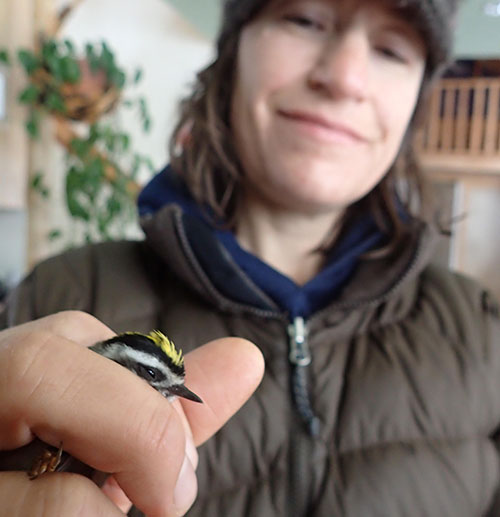
Pioneer songbird meets an early snowstormBy NED ROZELL
October 12, 2015
My wife, Kristen, heard it bump into the glass. She was soon cupping in her hands a delicate bird she saw perched on the windowsill. "It's a golden-crowned kinglet!" she said. Kristen is a bird biologist, but I was surprised at her identification. Mighty little ruby-crowned kinglets belt out their big songs in our woods each spring, but golden-crowns do not appear north of the Alaska Range on any maps of where the birds live. Neither of us remember seeing one here before.
Kristen Rozell holds a golden-crowned kinglet that hit a Fairbanks window during a snowstorm. Ned Rozell photo.
That little refugee was a fun mystery during a storm that deposited more than a foot of wet snow on our patch of boreal forest in less than one day. Kristen mixed some sugar and water in a Nalgene cap and touched a few droplets to the stunned bird's beak. Soon, she felt movement in her hands. "She's getting peppy." Kristen stepped outside and held her palm open. A bird that weighed as much as two pennies stood there in the cold, moist air. After one minute, it fluttered off. First it perched on roof metal. Then it moved to an umbrella-like space beneath snowy spruce branches. A chickadee that flew into the same tree right after the kinglet looked like a giant in comparison. Golden-crowned kinglets are even smaller than ruby-crowned kinglets: about as big as your thumb. What was one the smallest songbirds doing in a far-north forest at the start of winter? That's a good question. Kristen wonders if she's heard their high-pitched chatter in our neighborhood before, mistaking them for the similar calls of brown creepers. And it's hard to see those flitting little bodies as they branch-hop through the tips of 100-foot spruces. Maybe they are more common here than we know, and we only find them when something goes wrong. To learn more about the golden-crowned kinglet, I pulled out Bernd Heinrich's “Winter World.” The golden-crowned kinglet is the star of the biologist's book. I am "amazed when I step out in the morning after a cold night and I'm greeted by them," the University of Vermont emeritus professor wrote about golden-crowneds in Maine. "Our fragility in the cold makes the survival of these tiny creatures all the more miraculous." One would guess that the Fairbanks kinglet was not seeking to winter here, but rather bumped into a window during its migration to somewhere south of the Alaska Range. Most maps of the bird's range show it to wander as far north as Anchorage during the summer. From his own research and the little he could find from others, Heinrich wrote this of the songbird that inspired his book: Their tiny bodies (it would take 325 kinglets to equal one raven) stay at about 111 degrees Fahrenheit year-round and lose heat 100 times faster than ours. Kinglets need three times their body weight in food to survive a winter day. While roosting, they shiver, or else they would "freeze like a teaspoon of water." Heinrich and his graduate students clubbed trees with maple staffs to find the frozen caterpillars golden-crown kinglets fed upon most often during a Maine winter. After climbing a pine tree in the dark with a flashlight, he once found four kinglets huddled together on a branch beak-to-beak, looking like a ball of fluff. As much as I root for the Fairbanks kinglet to flap its way to a milder climate for winter, I realize the bird is maybe too bold a pioneer to pass on its genes. But a good deal of mortality might be a big part of golden-crowned kinglet strategy. The birds lay an unusual amount of eggs in their hammock nests that hang beneath spruce branches. Sometimes a pair will get two nests going at once. All those babies perhaps offset 87 percent of the entire population of golden-crowned kinglets being "weeded out" every year, Heinrich wrote. He compared them to an annual plant, which regenerates each year only by seeds. Heinrich concluded “Winter World” with this salute to the bird that felt a warm hand in the subarctic a few days ago: "I've felt an infectious hyperenthusiasm flow from them, and sensed a grand, boundless zest for life," Heinrich wrote. "They could not survive without that in their harsh world. Like us, they are programmed for optimism."
|
||
